Evolutionary Revolution: Esper’s Army Modernization Philosophy
Posted on
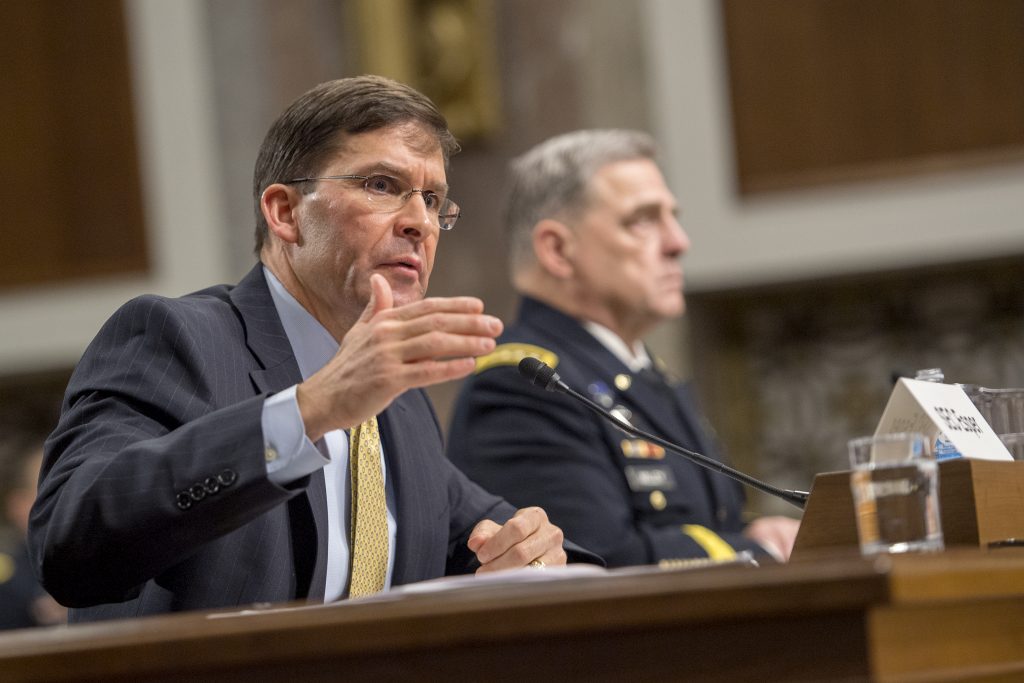
Army Secretary Mark Esper and Chief of Staff Gen. Mark Milley testify before the Senate.
WASHINGTON: The Army Chief of Staff wants revolutionary new weapons. The Army Secretary wants affordable technology fast. How can they reconcile these opposites? By building systems with off-the-shelf tech but leaving room to upgrade them with radically new tech when it’s ready, Secretary Esper said today. Call it evolutionary revolution.
Sec. Esper, a former Army Ranger and Trump appointee, wasn’t rebuking Gen. Mark Milley, a career soldier named Chief of Staff under Obama. The two men are in lockstep on the Army’s Big Six modernization priorities — “the Chief and I, we’ve sworn a blood oath not to change them,” Esper told reporters — and the need for a new Army Futures Command to streamline the service’s troubled acquisition system.
Nevertheless, there’s a difference in emphasis that we’ve noted in the past, with Milley’s rhetoric consistently grander and Esper’s more evolutionary. That’s in part a difference in temperament, in part a difference in roles, but it’s also a tension that may affect policy and budgets.
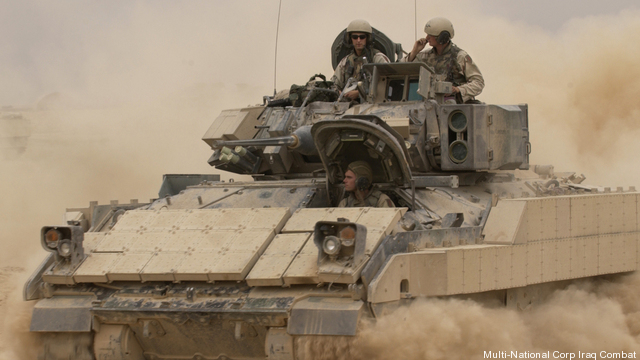
M2 Bradley In Iraq
Esper’s Case For Caution
So, speaking about Army modernization this afternoon at the Center for a New American Security, Esper repeatedly emphasized his preference for realistic goals that can be achieved on budget and schedule. “If you can bring technology to the field, to the force a lot quicker, you save money,” Esper told the CNAS audience. “If you… put much more emphasis on prototyping and leveraging current technologies and not developing blue sky, white chart types of things, you save money.”
“We’ve spent a lot of time, my senior acquisition executive (and I), with PEOs (Program Executive Officers) and PMs (Project Managers),” Esper said. “We’ve been very clear that our approach is not to look for… time-consuming, costly new development programs, but rather let’s look at the traditional defense industry, the commercial sector, particularly with regard to the network.”
Commercial information technology has advanced much faster than the government can keep up. But even in relatively slow-moving technologies like armored vehicles, Esper is open to buying off-the-shelf foreign designs, as the Army did for its eight-wheel drive Stryker.
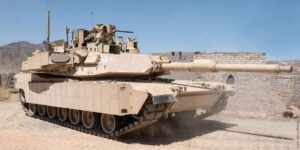
Army M1 Abrams tank with a trial installation of the Israeli-made Trophy Active Protection System (APS)
The Army can’t keep upgrading its current equipment forever, Esper emphasized, so it does need to buy something new, but that doesn’t mean something radically new. One of the most pressing examples is the M2 Bradley, a heavily armed and armored troop carrier that’s run out of electrical power and horsepower to handle further upgrades. Esper has consistently described the Army’s Next Generation Combat Vehicle initiative as a Bradley replacement, although the service is also exploring armed robots, and Milley has emphasized replacing the M1 Abrams as well.
Esper doesn’t want to replicate the lengthy, costly, and controversial process (complete with satirical movie) that led to the Bradley back in the 1970s and 1980s: “The Bradley was a development program and we’re committed to not going that route.”
As a general principle, “I don’t want to go (to a) white-sheet, long term development program, years to determine requirements,” Esper summed up. “We need to go with what we can assemble now in the next two-three years.” The Army’s top budget priority remains readiness for near-term crises, he said, but once readiness is restored to high levels ca. 2022, the secretary expects the funding emphasis will shift to modernization.
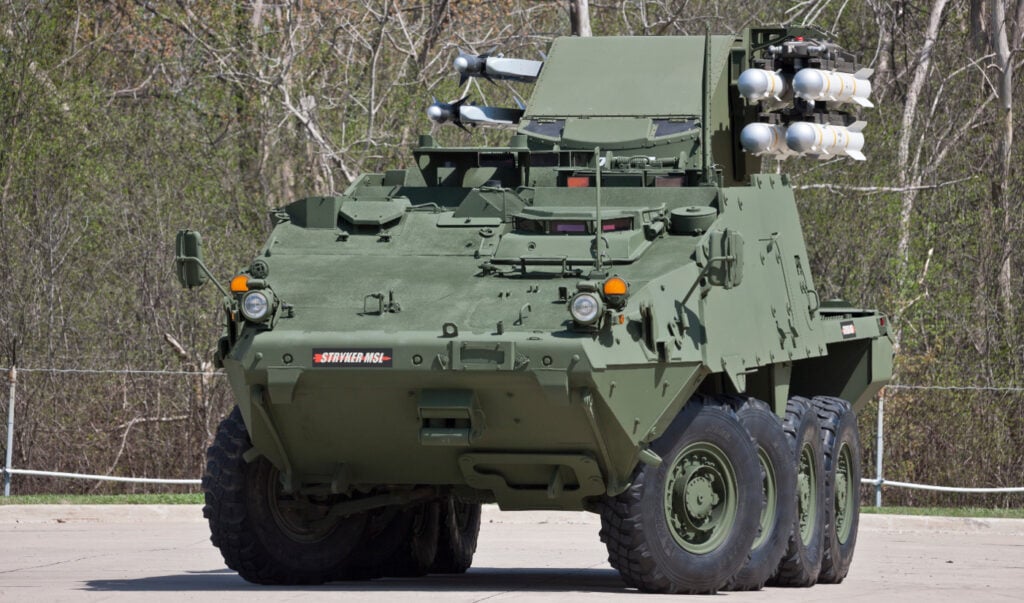
Stryker vehicle armed with anti-aircraft missiles (Boeing prototype)
Reconciling Evolution and Revolution
How can the Army reconcile Esper’s cost- and technology- conscious caution with Milley’s revolutionary ambitions, I asked just after his CNAS remarks. “Two examples,” Esper said:
“We’re putting a lot of research, a lot of dollars, into directed energy — lasers,” he said, “but I know I need air and missile defense now” against everything from ISIS drones to Russian jets to Chinese ballistic missiles.
“So I’m putting into the battlefield, beginning in 2020, a battery of Strykers, a Stryker chassis with traditional missiles on it (and) maybe a gun,” Esper said. “I know it’s going to take time to develop the laser, (but) I’m confident we’ll get there, (so) I want to make sure I build a vehicle that can accommodate that.”
It’s “the same thing with the Bradley replacement,” Esper said. While the Army’s Cross Functional Team (CFT) for Next Generation Combat Vehicle has an ambitious timeline for prototyping unmanned war machines, Esper emphasized that truly autonomous robots will take much longer — so we need to realize the revolution by evolutionary stages.
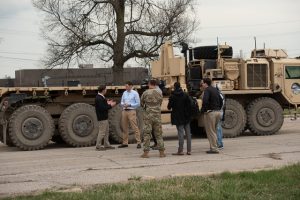
Army Secretary Mark Esper (left) getting briefed on the self-driving “leader-follower” autonomous vehicle (in background).
The Army has made significant progress in developing self-driving kits for existing trucks that let them follow a manned vehicle in convoy, something called “leader-follower” technology. That’s a far cry from independent maneuver across the battlefield, but it’s also a big improvement over always needing a human driver in each vehicle. And a vehicle that can do leader-follower today might be upgraded to operate more independently in the future.
“We can do leader-follower right now; I was in one of those first vehicles in Michigan a few weeks ago,” Esper said. “But I want to make sure as I build that first vehicle — because I need it now — (that) it has on board sufficient power, computing space, room inside the vehicle to accommodate fully developed semi autonomous and fully autonomous (technologies).”
Ultimately, “whoever gets to robotics and AI first, it’ll be a game changer on the battlefield,” Esper told reporters. But for all the commercial progress in driverless cars — which operate on paved roads with no one shooting at them — it’ll be some time before military artificial intelligence is ready. So, he said, ” we’ve just got to be able to build a vehicle today that, as that technology matures, you can install it.”
In short, don’t wait for fully autonomous robots. Build a vehicle today that can drive itself in limited circumstances, like supply convoys or clearing minefields, and leave room to upgrade it to something more autonomous over time. Don’t wait for battlefield lasers: Build a vehicle today that can fire existing anti-aircraft missiles, but leave room to add a laser when it’s ready.

B-52 bombers
This kind of design is, of course, easier to advocate for than to accomplish. Lasers, for instance, require a lot of electrical power and generate a lot of waste heat. Efficiency-minded engineers and members of Congress alike may dislike buying extra generating and cooling capacity that’s not needed today on the grounds we’ll probably need it in the future. And what form future technologies will actually take is notoriously hard to forecast.
Nevertheless, some of the most successful military vehicles have been those with room to grow. Consider the B-52 bomber, ridiculously over-engineered by modern standards but because of that robust enough to serve for 66 years and counting, with countless modifications large and small.
Or consider the M2 Bradley itself and its sister systems from the “Big Five” of the 1980s buildup, like the M1 Abrams tank and AH-64 Apache helicopter. All have been upgraded repeatedly, with everything from better targeting systems to heavier armor — “the Apache of today is not the Apache of 1986,” Esper noted — and have remained in service for almost 40 years.
It’s this model that Esper clearly wants to follow: “What we want to do,” he said, “is get a new platform we know we can continue to build upon and upgrade over time for decades.”
Subscribe to our newsletter
Promotions, new products and sales. Directly to your inbox.
